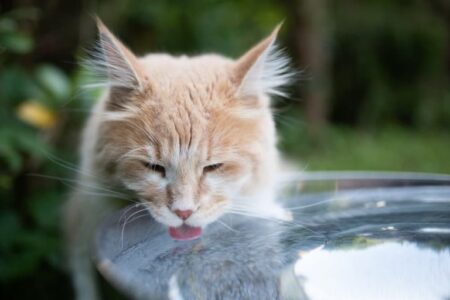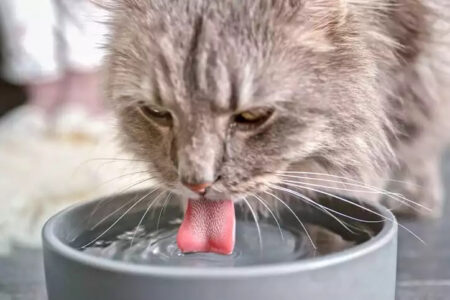If you are a cat owner, you may have noticed your furry friend drinking more water than usual. While it’s normal for cats to stay hydrated, excessive water consumption can sometimes indicate an underlying health issue. It is essential to pay attention if your cat’s water intake significantly increases, as it may be a sign of a potential problem. In this article, we will discuss when to worry about your cat drinking a lot of water and what potential causes could be behind this change in behavior.
When to Worry About Your Cat Drinking a Lot of Water
When it comes to your cat’s water intake, it’s important to understand their normal drinking habits. Cats typically consume about 5-10 ounces of water per day, depending on their size, age, and activity level. However, if you notice a significant increase in your cat’s water consumption, it may be a cause for concern.
One of the reasons to worry about your cat drinking a lot of water is polydipsia, which refers to excessive thirst. Polydipsia can be a symptom of an underlying medical condition such as:
- Diabetes: Cats with diabetes often develop increased thirst and urination. If your cat is also experiencing weight loss, increased appetite, and lethargy, it’s crucial to consult with a veterinarian for proper diagnosis and management.
- Kidney Disease: In the early stages of kidney disease, cats may drink more water to compensate for their compromised kidney function. Look out for other signs like increased urination, weight loss, vomiting, and changes in appetite.
- Hyperthyroidism: Overactive thyroid glands can cause increased thirst and water consumption. This condition is more common in older cats and may also present with weight loss, increased appetite, and restlessness.
- Urinary Tract Infections: Cats with urinary tract infections may drink more water to try and flush out bacteria from their system. Look for signs such as frequent urination, straining in the litter box, and blood in the urine.
- Liver Disease: Liver disease can affect a cat’s metabolism and cause increased thirst. Other symptoms may include jaundice (yellowing of the skin and eyes), loss of appetite, vomiting, and weight loss.
- Hypercalcemia: Elevated calcium levels in the blood can lead to increased thirst in cats. This can be caused by various conditions, including certain cancers, primary hyperparathyroidism, or ingestion of toxic substances.
Why is My Male Cat Drinking So Much Water?
If you have noticed that your male cat is drinking excessive water, it is important to understand the potential reasons behind this behavior. While increased water consumption can be a natural response to factors such as warmer weather or a change in diet, it may also indicate an underlying health issue. Here are some possible reasons why your male cat may be drinking so much water:
- Urinary Tract Infection (UTI): UTIs are common in male cats and can cause increased thirst and urination. Other symptoms of a UTI may include frequent urination, straining in the litter box, and blood in the urine. If you suspect a UTI, it is important to seek veterinary care for diagnosis and appropriate treatment.
- Diabetes: Diabetes mellitus is a condition that affects a cat’s ability to regulate blood sugar levels. Increased water consumption, along with increased appetite, weight loss, and lethargy, can be signs of diabetes. A veterinarian can perform tests to diagnose diabetes and develop a treatment plan to manage the condition.
- Kidney Disease: Chronic kidney disease is a progressive condition that affects the functioning of the kidneys. Cats with kidney disease may drink more water to compensate for their impaired kidney function. Other symptoms may include increased urination and urination accidents, decreased appetite, weight loss, and lethargy. A veterinarian can perform blood and urine tests to assess kidney function and recommend appropriate treatment options.
- Hyperthyroidism: Hyperthyroidism occurs when the thyroid gland produces an excess amount of thyroid hormone. Along with increased thirst, symptoms may include weight loss, increased appetite, restlessness, and hyperactivity. A veterinarian can perform blood tests to diagnose hyperthyroidism and discuss treatment options such as medication or dietary management.
- Medications or Dietary Factors: Certain medications or dietary factors can increase a cat’s thirst. For example, some medications may cause side effects such as increased thirst, while certain diets with high salt content can lead to increased water intake. If you suspect that a medication or diet change may be contributing to your cat’s increased water consumption, consult with your veterinarian for guidance.
It is important to monitor your male cat’s water intake and note any changes in behavior. If you believe that your cat is drinking an excessive amount of water, it is recommended to schedule a visit with the veterinarian. They can perform a thorough examination, run necessary tests, and recommend appropriate treatment if needed.
How Much Water Should a Cat Drink?
Cats should generally drink about 5-10 ounces of water per day to maintain proper hydration. However, it’s important to note that individual cats may have different water intake needs based on factors such as their size, age, activity level, and diet.
One way to ensure that your cat is getting enough water is to provide them with fresh, clean water in a clean bowl at all times. Some cats prefer running water, so you may want to consider using a cat water fountain or dripping faucet to entice them to drink more.
Additionally, cats obtain moisture from their food, especially if they consume wet or canned food. This can contribute to their overall water intake. If your cat primarily eats dry food, you may consider adding some moisture to their diet by mixing in wet food or adding water to their kibble.
It is important to monitor your cat’s water intake and look for any significant changes in their drinking habits. If you notice a sudden increase or decrease in their water consumption, it may be a sign of an underlying health issue. Consulting with a veterinarian is always recommended if you have concerns about your cat’s water intake.
SEE ALSO: Can Dogs Eat Chicken Nuggets?
Cat Drinking a Lot of Water and Meowing
If your cat is drinking a lot of water and meowing, it could be a sign that something is wrong. Excessive thirst and vocalization can be indicative of several different health problems, including diabetes, kidney disease, and hyperthyroidism. If your cat is showing these symptoms, it’s important to take them to the vet for a checkup. Your vet will be able to run some tests to figure out what’s going on and recommend a treatment plan. In the meantime, make sure your cat has access to plenty of clean water to drink.
Dehydration in Cats: Symptoms and Causes
Dehydration occurs when there is a lack of adequate fluid in the body, and it can be a serious health concern for cats. As a responsible pet owner, it is important to be aware of the signs and causes of dehydration in cats. Here is some information to help you identify and understand dehydration in your feline friend.
Symptoms of dehydration in cats:
- Lethargy or lack of energy
- Dry or tacky gums
- Sunken eyes
- Loss of skin elasticity
- Decreased urination
- Panting or increased breathing
- Loss of appetite
- Constipation
- Dark yellow or concentrated urine
Causes of dehydration in cats:
- Inadequate water intake: Cats may become dehydrated if they do not drink enough water. This can occur due to various reasons, such as inaccessible or unappealing water sources, or medical conditions that cause increased thirst.
- Vomiting or diarrhea: When cats have gastrointestinal issues that lead to frequent vomiting or diarrhea, they can quickly lose fluids and become dehydrated. It is important to monitor your cat’s bowel movements and seek veterinary attention if these issues persist.
- Heatstroke: Exposure to high temperatures and prolonged heat can cause cats to become dehydrated. Cats are more susceptible to heatstroke due to their limited ability to sweat and regulate body temperature. It is essential to provide a cool and shaded environment for your cat, especially during hot weather.
- Illness or disease: Certain medical conditions like kidney disease, diabetes, or urinary tract infections can result in increased water loss through urination or other symptoms that can lead to dehydration. These conditions require proper medical diagnosis and treatment from a veterinarian.
- Medications: Some medications or treatments can cause increased thirst or fluid loss, leading to dehydration. If your cat is on any medication, it is important to discuss potential side effects with your veterinarian.
- Stress or anxiety: Cats may experience stress or anxiety due to changes in their environment, such as moving to a new home, the introduction of a new pet, or during travel. Stress can result in decreased water intake and contribute to dehydration.
How Do I Know If My Cat is Drinking Too Much Water?
Monitoring your cat’s water intake is crucial to identify any changes in their drinking habits. While the amount of water a cat drinks can vary based on factors like age, size, and activity level, excessive water consumption may indicate an underlying issue. Here are some signs that your cat may be drinking too much water:
- Increased frequency of water bowl refills: If you find yourself constantly refilling your cat’s water bowl because they finish it quickly, it could be a sign of increased water intake.
- More frequent trips to the water bowl: If your cat is making more trips than usual to the water bowl throughout the day, it may indicate excessive thirst.
- Large amounts of water being consumed: If you notice that your cat is consistently drinking large quantities of water in one sitting, it may be a cause for concern.
- Increased urine output: Cats who are drinking excessive amounts of water will likely have increased urination. You may notice more frequent litter box usage or larger urine clumps.
- Behavioral changes: Excessive thirst can sometimes cause changes in your cat’s behavior. They may become more restless, exhibit signs of discomfort or agitation, and become more vocal.
My Cat is Drinking a Lot of Water and Not Eating
If your cat is drinking a lot of water and not eating, it could be a sign of a serious health problem. One possible cause is diabetes. When cats have diabetes, their bodies cannot properly regulate their blood sugar levels, which can lead to excessive thirst and weight loss. Another possible cause is kidney disease. Kidney disease can cause cats to urinate more frequently, leading to dehydration and increased thirst. If your cat is showing these symptoms, it’s important to take them to the vet as soon as possible. Early diagnosis and treatment are key to managing these conditions and improving your cat’s quality of life.
How to Help a Cat Who Is Drinking Too Much Water
If you suspect that your cat is drinking too much water, it is important to address the issue promptly and seek veterinary care. Here are a few steps you can take to help your cat who is drinking excessive amounts of water:
- Schedule a veterinary appointment: Consult with a veterinarian to discuss your concerns about your cat’s increased water intake. They will perform a thorough examination, ask questions about your cat’s behavior and medical history, and run diagnostic tests to identify any underlying causes.
- Follow veterinary recommendations: Depending on the cause of your cat’s excessive thirst, the veterinarian may recommend specific treatments or lifestyle changes. Follow their instructions, administer any prescribed medications, and make any necessary adjustments to your cat’s diet or environment.
- Ensure access to fresh water: While it may seem counterintuitive, it is important to provide your cat with unlimited access to fresh and clean water. Make sure their water bowl is cleaned daily, and consider using a pet water fountain, as some cats prefer running water. Multiple water bowls placed in different areas of the house can also encourage your cat to drink more.
- Monitor water intake: Keep track of your cat’s water intake to share this information with your veterinarian. Measure how much water you are refilling in the bowl each day and note any significant changes. This can help the veterinarian in their assessment and treatment plan.
- Offer wet food: Increasing moisture content in your cat’s diet can help to hydrate them further. Consider incorporating wet or canned food into their diet, as it contains a higher water content compared to dry kibble. Consult with your veterinarian for appropriate dietary recommendations.
- Provide a stress-free environment: Stress and anxiety can contribute to increased water intake in cats. Create a calm and secure environment for your cat by providing hiding spots, vertical spaces, and plenty of mental and physical stimulation. Minimizing changes or disruptions in their environment can also help reduce stress levels.
SEE ALSO: Is Dawn Dish Soap Safe for Dogs?
FAQs
Q. How do you know if your cat is overhydrated?
A. If you’re concerned that your cat might be overhydrated, there are a few things you can look for. First, check their gums. If they are pale or pinkish in color, it could be a sign that they are overhydrated. You can also check their eyes. If the whites of their eyes are very red, this could also be a sign of overhydration. Finally, you can feel their skin. If it feels damp, this could also be a sign that they are overhydrated.
Q. How much water should a cat drink in 24 hours?
A. In general, most cats should drink between 3 and 4 ounces of water per pound of body weight per day. So, for example, a 10-pound cat should drink between 30 and 40 ounces of water per day. However, it’s important to keep in mind that every cat is different, and some may need more or less water than this. Some factors that can affect how much water a cat needs include their age, activity level, health, and diet.
Q. Should I be worried if my cat drinks a lot of water?
A. While increased water intake can be a sign of a health problem in cats, it’s not always cause for concern. Some cats simply drink more water than others, and this is not necessarily a cause for alarm. However, if your cat is drinking a lot more water than usual and you notice any other changes in their behavior, such as increased urination, lethargy, or weight loss, it’s important to have them checked out by a veterinarian. These could be signs of a serious health problem like diabetes, kidney disease, or hyperthyroidism.
Conclusion
In conclusion, it is essential to pay attention when your cat starts drinking a lot of water, as it may be a sign of an underlying health issue. Excessive water consumption, or polydipsia, can be caused by conditions such as diabetes, kidney disease, hyperthyroidism, urinary tract infections, liver disease, or hypercalcemia. It is important to monitor your cat’s water intake and watch for other symptoms like increased urination, weight loss, vomiting, or changes in appetite. If you notice any concerning signs, it is recommended to consult with a veterinarian for proper diagnosis and treatment. Early detection and intervention can help manage these conditions and ensure the well-being of your feline companion.


